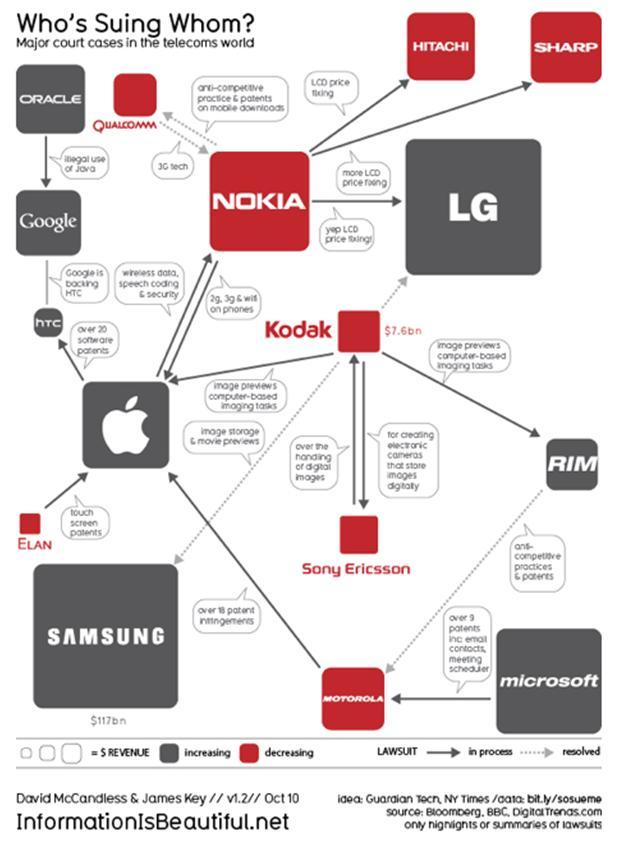Blogs review: the patent war in IT
What’s at stake: Apple’s recent victory in its ongoing dispute over IP rights with Samsung has received a great deal of attention from regulators, aca
What’s at stake: Apple’s recent victory in its ongoing dispute over IP rights with Samsung has received a great deal of attention from regulators, academics and the media worldwide. It is, however, just one of the many battles of an ongoing war in the IT sector over intellectual protection. Standard economic analysis sees IP protection as a trade-off between securing a fair reward for innovators while ensuring that future innovation is not jeopardized and that customers pay a fair price. Although the aim of the patent system is to strike the right balance between these two broad objectives, recent developments – for example patent trolls, patent thickets and ambush strategies – suggest that the balance has tipped towards incumbents.
The scale of the problem
Brad Plumer writes at the Wonk blog that it’s no secret that patent litigation has taken off in the past few decades. In nearly every country, patent offices are getting flooded – not only with genuine patent litigation – but also with more and more patents for dubious or low-quality inventions. In a 7 pages report, the New-York Times notes that as much as $20 billion was spent on patent litigation and patent purchases in the last two years in the smartphone industry alone. And for the first time, spending by Apple and Google on patent lawsuits and unusually big-dollar patent purchases exceeded spending on research and development of new products last year.
Randy Picker writes at the University of Chicago Faculty blog that it is a misconception to see the recent increase in the use of patent-buying and patent lawsuits as a distortion of the role of patents. The whole point of a patent is to be able to enforce it. Given the system we have today, it isn’t at all surprising that an innovative firm like Apple holds patents that, by design, make it possible for Apple to block sales by competitors to eager customers.

Note: For a more recent (but less readable) version of that information, see here.
The economics of the patent system redux: an application to the IT sector
Evan Soltas writes that what is in doubt is whether copying is something courts should prevent. What is in jeopardy is the complex relationship between imitation and innovation, the trade-off between a bountiful stock of public knowledge and the incentives that encourage a flow of discovery. What is – or ought to be – in question is the proper role of patent law in the 21st century.
Timothy Taylor explains that the basic economics of patents is a balancing act: on the one hand, patents provide an incentive for innovation, by giving innovators a temporary monopoly over the use of their invention. On the other hand, the temporary monopoly power of the inventor means that consumers pay higher prices (although consumers of course also benefit from the existence of the innovation).
Richard Posner argues that the problem of excessive patent protection is at present best illustrated by the software industry. Most software innovation is incremental, created by teams of software engineers at modest cost, and also ephemeral — most software inventions are quickly superseded. Software innovation tends to be piecemeal — not entire devices, but components, so that a software device (a cellphone, a tablet, a laptop, etc.) may have tens of thousands, even hundreds of thousands, of separate components (bits of software code or bits of hardware), each one arguably patentable. The result is huge patent thickets, creating rich opportunities for trying to hamstring competitors by suing for infringement. Further impediments to effective patent policy in the software industry include a shortage of patent examiners with the requisite technical skills, the limited technical competence of judges and jurors, the difficulty of assessing damages for infringement of a component rather than a complete product, and the instability of the software industry because of its technological dynamism.
Erik Maskin (HT Marginal Revolution) – a 2007 Nobel prize in economics – writes in a letter to the New-York Times that in an industry with highly sequential innovation, it may be better for society to scrap patents altogether than try to tighten them.
Adam Mossof writes at the Truth in the Market blog that the experience of the equally difficult, confusing, cutting-edge patented innovation of their day in vulcanized rubber, sewing machines, the telegraph, among many others illustrate that inventors and the firms that commercialized their inventive work-product knew what was needed to obtain and enforce their patents. The complaints about software patents arise more from intuitions, from unrealistic assumptions about how much certainty we can achieve in the patent system, and from emotionally compelling anecdotes about innovators running into trouble with patents. But they run against historical evidence.
The strategic use of IT patents
Ilene Gotts and Scott Sher argue that patents are increasingly being purchased and used for anticompetitive means. These include extraction of high licensing fees by patent assertion entities (or patent trolls, companies that exist solely to sue over patent violations), the creation of blocking positions by incumbent companies as well as the creation of “patent thickets” – an overlapping set of patent rights, which require innovators to reach licensing deals for multiple patents from multiple sources.
Per Hellstrom and Thomas Kramler explain that standardization processes represent another opportunity for companies to make a strategic use of their patents. The existence of "standard essential patent" (“SEP”), patents that are essential to the implementation of standards, create a well known “hold up” problem, whereby the SEP holder can extract a higher payment than the one that was attributable to the value of the patented technology before the standard was set. Standards organizations generally require both prior disclosure of potentially essential Intellectual Property Rights (or IPRs) and a commitment to license those IPRs on fair reasonable and non-discriminatory—FRAND—terms. However, these requirements do not necessarily end all problems. For example, non-disclosure of IPRs can lead to patent "ambush" strategies, whereby a company intentionally reveals that it holds a SEP only after the standard is set in order to claim unreasonable royalties.
Randy Picker writes that there is a great deal to be said in defense of patent trolls. While their dismissal appears consensual (typically, they don’t build products and just enforce patents earned by others), there are virtues in the separation of invention, production and enforcement, and patent trolls provide exit markets for inventors.
The role of antitrust authorities in IT technology
David Balto writes that representatives from the Department of Justice Antitrust Division, the Federal Trade Commission, and the European Commission made it clear in a recent series of speeches that they intend to broaden their patent and competition focus to go beyond traditional challenges such as patent misuse, or price fixing through licensing in order to include practices such as unilateral aggregation of patents by a competitor, collaborative acquisition and aggregation of patents by competitors, business practices of non-practicing entities ("NPE"), whom the industry has described as "trolls" and which are sometimes referred to as "patent assertion entities", transfer of patent rights to trolls by legitimate competitors and the subsequent economic relationship between the competitor and the troll and business practices of unwilling licensees within the standard-essential patents (SEP) context, and whether an unwilling licensee may be subject to equitable relief for failure to negotiate in good faith.
Ilene Gotts and Scott Sher argue that patents are not free from application of the antitrust laws. There are four main factual scenarios that may implicate the antitrust laws: (1) collaborative patent collection by competitors; (2) a patent acquisition that creates a blocking position; (3) a patent acquisition that creates a patent thicket; and (4) an acquisition by a patent troll. In technology markets, where market shares are often not an indication of market power or lack thereof, a merger could result in a small combined market share, but could create significant market power if the parties hold competing patent portfolios that, as a combined entity, would create a blocking position or patent thicket where none previously existed. Similarly, the acquisition of patents by non-practicing entities (i.e. patent trolls) also raises significant competitive concerns that must be evaluated by enforcers. Acquisition of a patent by an entity that does not practice the technology may increase market power because the patent troll can increase royalties, deny licenses, or otherwise increase enforcement without fear of countersuit for infringement.
In a lunch talk at Bruegel last week, Pierre Regibeau argued that the old “rule” restricting competition authorities to the use of IPRs wielding market power and keeping it away from IPR design does not look so bad. This being said, the role of competition policy also be to modulate the application of IPRs across different sectors and to address the perceived failures of the IP system.
